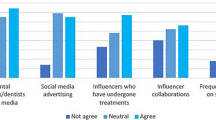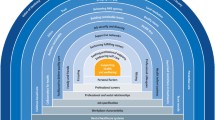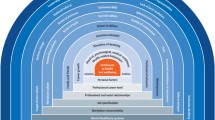Abstract
Aim To explore dentists' perceptions and use of social media generally and in relation to their professional careers, together with its implications for professionalism.
Methods Semi-structured interviews were conducted with dentists in their early, mid- and late careers working in a range of settings based in London. Participants were purposively sampled via gatekeeper organisations, supported by snowball sampling. Interviews were audio-recorded, transcribed verbatim and data were analysed using thematic analysis.
Results Eighteen dentists working across a range of career stages and care settings were interviewed. Participants were aware of the risks and benefits of using social media and expressed ways of balancing them. A typology of social media user types in the dental profession emerged from the data, comprising avoiders, secondary users, occasional users, observers, seekers, active and cautious, limited, engaged users and deleters. Participants reported an awareness of the impact of maintaining professionalism when using social media.
Conclusion Among the participant population sampled, the risks and benefits of general and professional social media were discussed and, in some cases, these overlapped. The findings suggest that dentists are aware of the risks and benefits and employ techniques to balance risk. There were a range of social media user types that varied by characteristics, use in learning and the influences that change their use. It was evident that social media plays an important role in communication between those dentists engaging with available platforms. This area requires further research into professionalism and social media in dentistry.
Key points
-
Social media can play an important role in communication between dentists. This study suggests that dentists are aware of the risks and benefits of using social media and employ some management techniques to balance them.
-
Analysis suggests a range of social media user types representing their views, use and how they use social media in learning.
-
Given that social media is constantly evolving, dentists should be equipped with the right understanding and skills to manage and use these platforms throughout their professional careers.
This is a preview of subscription content, access via your institution
Access options
Subscribe to this journal
Receive 24 print issues and online access
$259.00 per year
only $10.79 per issue
Buy this article
- Purchase on SpringerLink
- Instant access to full article PDF
Prices may be subject to local taxes which are calculated during checkout
Similar content being viewed by others
References
World Wide Web Foundation. History of the Web. 2018. Available at https://webfoundation.org/about/vision/history-of-the-web/ (accessed November 2020).
Office for National Statistics. Internet access - households and individuals. 2018. Available at https://www.ons.gov.uk/peoplepopulationandcommunity/householdcharacteristics/homeinternetandsocialmediausage/bulletins/internetaccesshouseholdsandindividuals/2019 (accessed November 2020).
Carr C T H, Rebecca A H. Social Media: Defining, Developing and Divining. Atl J Commun 2015; 23: 46-65.
Obar J A, Wildman S. Social media definition and the governance challenge: An introduction to the special issue. Telecomm Policy 2015; 39: 745-750.
Kaplan A M, Haenlein M. Users of the world, unite! The challenges and opportunities of social media. Bus Horiz 2010; 53: 59-68.
Bhola S, Hellyer P. The risks and benefits of social media in dental foundation training. Br Dent J 2016; 221: 609-613.
Melkers J, Hicks D, Rosenblum S, Isett K I, Elliott J. Dental Blogs, Podcasts, and Associated Social Media: Descriptive Mapping and Analysis. J Med Internet Res 2017; DOI: 10.2196/jmir.7868.
Petrucci A M, Chang M, Wexner S D. Social Media: Changing the Paradigm for Surgical Education. Clin Colon Rectal Surg 2017; 30: 244-251.
Spallek H, Turner S P, Donate-Bartfield E et al. Social Media in the Dental School Environment, Part A: Benefits, Challenges, and Recommendations for Use. J Dent Educ 2015; 79: 1140-1152.
Ventola C L. Social media and health care professionals: benefits, risks, and best practices. P T 2014; 39: 491-520.
General Dental Council. Guidance on using social media. 2016. Available at https://www.gdc-uk.org/docs/default-source/student-faqs/guidance-on-using-social-media.pdf (accessed November 2020).
General Dental Council. CPD for dental professionals. 2019. Available online at https://www.gdc-uk.org/education-cpd/cpd (accessed February 2018).
General Dental Council. Enhanced CPD scheme 2018. 2018. Available online at https://www.gdc-uk.org/education-cpd/cpd/enhanced-cpd-scheme-2018/ (accessed February 2018).
Bullock A, Firmstone V, Fielding A, Frame J, Thomas D, Belfield C. Participation of UK dentists in continuing professional development. Br Dent J 2003; 194: 47-51.
Spallek H, Turner S P, Donate-Bartfield E et al. Social Media in the Dental School Environment, Part B: Curricular Considerations. J Dent Educ 2015; 79: 1153-1166.
Maloney S, Tunnecliff J, Morgan P et al. Translating Evidence Into Practice via Social Media: A Mixed-Methods Study. J Med Internet Res 2015; DOI: 10.2196/jmir.4763.
Trathen A, Gallagher J E. Dental professionalism: definitions and debate. Br Dent J 2009; 206: 249-253.
Neville P, Waylen A. Social media and dentistry: some reflections on e-professionalism. Br Dent J 2015; 218: 475-478.
Holden A. Social media and professionalism: does the profession need to re-think the parameters of professionalism within social media? Aust Dent J 2017; 62: 23-29.
Kenny P, Johnson I G. Social media use, attitudes, behaviours and perceptions of online professionalism among dental students. Br Dent J 2016; 221: 651-655.
Hamm M P, Chisholm A, Shulhan J et al. Social media use by health care professionals and trainees: a scoping review. Acad Med 2013; 88: 1376-1383.
Cheston C C, Flickinger T E, Chisolm M S. Social media use in medical education: a systematic review. Acad Med 2013; 88: 893-901.
Snelson C L. Qualitative and Mixed Methods Social Media Research: A Review of the Literature. Int J Qual Methods 2016; DOI: 10.1177/1609406915624574.
Hazzam J, Lahrech A. Health Care Professionals' Social Media Behaviour and the Underlying Factors of Social Media Adoption and Use: Quantitative Study. J Med Internet Res 2018; DOI: 10.2196/12035.
Hagg E, Dahinten V S, Currie L M. The emerging use of social media for health-related purposes in low and middle-income countries: A scoping review. Int J Med Inform 2018; 115: 92-105.
Vanzetta M, Molin A D, Vellone E, Alvaro R, Arrigoni C. Social media and nurse education: an integrative review of the literature. Ann Ig 2016; 28: 187-201.
Surani Z, Hirani R, Elias A et al. Social media usage among health care providers. BMC Res Notes 2017; 10: 654.
Bolderston A, Watson J, Woznitza N et al. Twitter journal clubs and continuing professional development: An analysis of a #MedRadJClub tweet chat. Radiography (Lond) 2018; 24: 3-8.
Gonzalez S M, Gadbury-Amyot C C. Using Twitter for Teaching and Learning in an Oral and Maxillofacial Radiology Course. J Dent Educ 2016; 80: 149-155.
Snyman L, Visser J H. The adoption of social media and social media marketing by dentists in South Africa. SADJ 2014; 69: 258, 260-264.
Arnett M R, Loewen J M, Romito L M. Use of social media by dental educators. J Dent Educ 2013; 77: 1402-1412.
Haas J, Park J H. Management & marketing: orthodontic marketing through online social networks. J Clin Orthod 2012; 46: 159-164.
Knosel M, Jung K, Bleckmann A. YouTube, dentistry, and dental education. J Dent Educ 2011; 75: 1558-1568.
Neville P. Social media and professionalism: a retrospective content analysis of Fitness to Practise cases heard by the GDC concerning social media complaints. Br Dent J 2017; 223: 353-357.
de Peralta T L, Fields Farrior O, Flake N M, Gallagher D, Susin C, Valenza J. The Use of Social Media by Dental Students for Communication and Learning: Two Viewpoints: Viewpoint 1: Social Media Use Can Benefit Dental Students' Communication and Learning and Viewpoint 2: Potential Problems with Social Media Outweigh Their Benefits for Dental Education. J Dent Educ 2019; 83: 663-668.
Office for National Statistics. Internet access - Households and Individuals. Table 10: Internet Activities by age group, sex and disability status. 2019. Available at https://www.ons.gov.uk/peoplepopulationandcommunity/householdcharacteristics/homeinternetandsocialmediausage/datasets/internetaccesshouseholdsandindividualsreferencetables (accessed November 2020).
Ritchie J, Lewis J, Nicholls C M, Ormston R (eds). Qualitative research practice: a guide for social science students and researchers. Second edition. Los Angeles: Sage, 2014.
Creswell J W. Research design: qualitative, quantitative, and mixed methods approaches. Fourth edition. California: Sage, 2014.
Larkin M, Thompson A R. Interpretive phenomenological analysis in mental health and pyschotherapy research. In Harper D, Thompson A R (eds) Qualitative Research Methods in Mental Health and Pyschotherapy: An Introduction for Students and Practitioners. pp 101-116. Chichester: Wiley-Blackwell, 2012.
Braun V, Clarke V. Using thematic analysis in pyschology. Qual Res Psychol 2006; 3: 77-101.
Brandtzaeg P B, Heim J. A typology of social networking site users. Int J Web Based Commun 2011; 7: 28-51.
Oakley M, Spallek H. Social media in dental education: a call for research and action. J Dent Educ 2012; 76: 279-287.
Shuttleworth J, Smith W. NHS dentistry: The social media challenge. Br Dent J 2016; 220: 153.
Dobson E, Patel P, Neville P. Perceptions of e-professionalism among dental students: a UK dental school study. Br Dent J 2019; 226: 73-78.
Acknowledgements
The authors would like to thank the participants for their time in taking part in the study.
Author information
Authors and Affiliations
Corresponding author
Ethics declarations
The authors declare no conflicts of interest.
Rights and permissions
About this article
Cite this article
Mondkar, A., Scambler, S. & Gallagher, J. Hashtag, like or tweet: a qualitative study on the use of social media among dentists in London. Br Dent J (2021). https://doi.org/10.1038/s41415-021-2655-2
Received:
Accepted:
Published:
DOI: https://doi.org/10.1038/s41415-021-2655-2
This article is cited by
-
‘It doesn't matter where you come from, it matters where you go': Peninsula dental students' career decisions and intentions
British Dental Journal (2025)
-
Real dentistry amidst the reels
British Dental Journal (2021)



